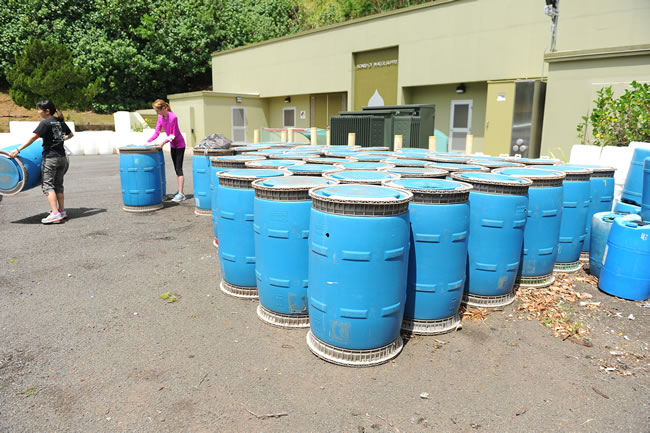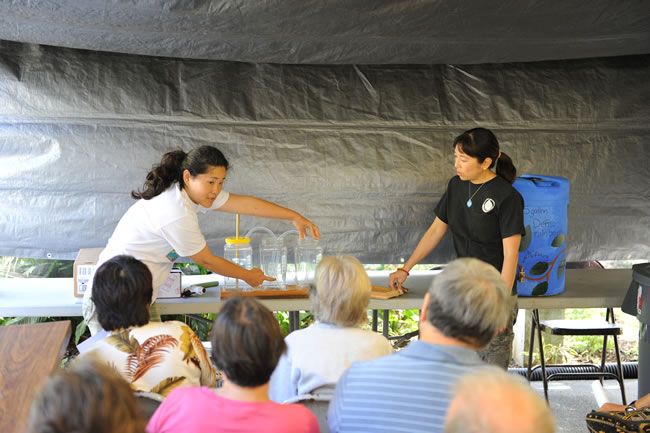Catching Rain
Saving precious water is an utmost concern, and Board of Water Supply specialists offer classes at Halawa Xeriscape Garden to teach us how
Standing in front of a packed room at Halawa Xeriscape Garden in Aiea, Board of Water Supply watershed resource specialist Amy Tsuneyoshi points to a barrel behind her and explains to the crowd that the barrel should be placed beneath where the rain flows off your roof. Cat Sawai, a BWS civil engineer in the water resources and water conservation section, adds that this 55-gallon water barrel will fill up with rainwater very quickly.
Amy Tsuneyoshi and Cat Sawai
It might not look like much, but this barrel can help conserve water.
In fact, Sawai and Tsuneyoshi estimate that implementing a rain barrel can save 2,200 gallons per year per household by capturing rainwater that can then be used for outdoor water needs. The class is Halawa Xeriscape Garden’s Rain Barrel Catchment workshop, and it’s just one of the many water-saving initiatives at HXG.
BWS estimates that a single family residential household of three to four occupants uses 400 gallons of water per day – totaling thousands of gallons per month. And a staggering 50 percent of the water consumption in the average single family home is used outdoors on activities that include watering plants and washing cars.
Opened in 1989, HXG is run by the Board of Water Supply as a way to demonstrate landscaping techniques and various plants that require less irrigation. The word xeri comes from the Greek word for “dry” – and all the plants scattered about the garden are un-thirsty plants, meaning that they require less water than other plants. These include rosemary, cactus, crown flower and desert rose, as well as a number of native plants.
“The garden was put here because each household, by doing xeriscape, can cut back their total water usage,” explains BWS community relations specialist Diane Moses, who also is a certified master gardener. According to BWS projections, households can cut up to 50 percent of their water usage by integrating xeric plants and practices.
With these initiatives, BWS is creating something of a DIY army within the community to help conserve water.
Most of Hawaii’s water supply is from underground sources, as the state’s landscape operates as a natural filtering and storage system into underground reservoirs known as aquifers. The aquifers are filled when rainwater seeps through the ground. Water is then extracted from the aquifers for a variety of uses.
“We are lucky to have the underground sources available to us,” Moses says, explaining that groundwater can be a safer source because it has fewer contaminants than surface water, which often contains runoff or sediment. “We are very lucky. That is why it is important we conserve, so that we can continue to have it.”
But groundwater is a finite resource. According to 2005 projections from the state Department of Land and Natural Resources, the use of water grows by 2 million to 3 million gallons per day each year on Oahu alone. With this growth rate, all available ground-water supplies on Oahu may be allocated within the next 20 to 30 years. The report also says that in some parts of the state, certain aquifers already are facing degradation.
“Our biggest challenge in water conservation is to get people to use only what they need,” Moses says.
HXG offers the public easy, accessible ways to conserve water. And although this might be a challenge, evidence suggests that it’s not because the intent isn’t there. In 2009, BWS conducted a market study to analyze the water-saving habits of the public. A majority of the participants expressed a strong desire to help conserve water.
“Many of them wanted to save water – they know how precious it is,”
Sawai explains of the study. “But they didn’t know quite what steps to take … But they do want to do their part.”
And if anything is indicative of the community’s desire to help conserve water, it’s the crowd at Sawai and Tsuneyoshi’s Rain Barrel Catchment workshop, which has been attracting participants in droves since it launched in 2008.
“Constructing a barrel is very fast,” Tsuneyoshi explains, saying it could take as little as five minutes. “You just make a hole and plug in the tap.” As part of the class, participants can take home one pre-drilled 55-gallon water catchment barrel with a $35 fee.
The class is designed to cover the basics of constructing, installing and maintaining a rain barrel, but Sawai and Tsuneyoshi hope that participants will use the class as a jumping off point for even more water savings.
“We want to teach them the basics and get them started, but really our goal is for them to expand their system so they have a larger catchment system and save more water,” Sawai says.
The amount of water savings increases with each barrel added. Tsuneyoshi has her own catchment system comprised of multiple barrels and is able to gather nearly all of her nonpotable water from it.
“It’s kind of addicting,” she says. “I started off with one barrel, and then one is not enough, and then I kept adding to the system.”
In addition to this workshop, HXG has a number of others that address topics that include aquaponics and spiral gardens, as well as fun activities for keiki such as Halloween pumpkin planting and Easter egg decorating. Master gardeners Brian and Mhel Cyr also teach a workshop called Unique Container Gardening: Fundamentals + Creativity, which teaches participants how to choose the right kind of container for their plant. While plants in containers typically must be watered more frequently than plants in the ground, simply using the right kind of container can make a big difference. Plants in plastic containers, for example, require very little water to thrive.
Other HXG educational initiatives include hosting school groups and tours through the garden.
One of HXG’s biggest events is the annual un-thirsty plant sale and open house – and this year’s takes place Saturday (Aug. 4) from 9 a.m. to 3 p.m. A variety of xeric and native plants will be available for purchase from about a dozen vendors. The event also will include brief xeriscape workshops, including condensed versions of both the rain barrel and container gardening classes, garden tours, keiki activities and more. Proceeds benefit educational programs and classes at the garden. Also on the day of the plant sale, HXG will unveil its new list of workshops for the coming year.
As the workshop draws to a close, the participants collect their new rain barrels one by one, loading them into their cars and driving off, hauling their barrels home. With the 23 participants in class that day – each of them conserving at least 2,200 gallons of water per year with the new catchment barrel – that equals a lot of water savings.
“We push conservation, as that is the cheapest source of supply right now,” Sawai explains. “If we drill a well, it will cost so many dollars per gallon versus conservation. To ask people to do a rain barrel or just shut your water off when brushing your teeth – those things are free and can save so much water. Why not do those things first before we go to a very expensive alternative resource? … At some point that will be inevitable, we know that. But we will utilize what can now.”
“You might look at this one (rain) barrel and you might not think it is much,” Sawai says. “But collectively, it is a lot … Each individual effort, collectively, will contribute to a much greater benefit.”
For more information, visit hbws.org.







